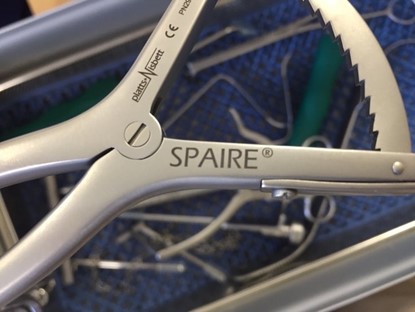The tendon-sparing SPAIRE technique for hip replacement
29 November 2023
By Professor John Timperley
Introduction
In 2016, I developed a tendon-sparing technique appropriate for all routine primary hip replacement cases which Saves Piriformis And (Obturator) Internus with Repair of (Obturator) Externus (SPAIRE technique). I have used this technique for all hip replacements since then; for the last 5 years SPAIRE has been facilitated by use of Mako robotic assistance.
SPAIRE/Mako now constitutes the standard of care in my practice.
What is the SPAIRE technique?
SPAIRE is a tendon-sparing posterior approach to the hip joint. In the technique an approach is developed in the interval between the inferior gemellus and Quadratus Femoris such that Obturator Externus is the only tendon divided and this is ultimately repaired along with the posterior capsule.
In practical terms, leaving most of the Quadriceps Coxa (QC) intact confers benefit in judging leg length and offset and greatly enhances stability of the joint. A bone hook is necessary to dislocate the joint after trial reduction as the intact Obturator Internus passes over the head at, or below, the centre of rotation of the hip and acts as a strap holding the joint reduced.
Background
Dr. Yoshiaki Ito et al.1 studied the trochanteric attachment of the short external rotators in detail and demonstrated that Obturator Internus is usually inserted in a more caudal, anterior, and medial position than Piriformis. Dr. Vaarbakken et al.2 noted that the “short external rotators” act together as a “quadriceps coxa” which functions as a primary abductor and extensor of the hip from flexed positions and is therefore of importance in rising from the seated position and propulsive motions. It became apparent that hip arthroplasty could be performed leaving all tendons except Obturator Externus intact.
Several surgeons in South Korea have been carrying out surgery through the same interval. In 2008 Dr Kim published a paper entitled Modified Posterior Approach to Total Hip Arthroplasty to Enhance Joint Stability3. He described a study comparing the dislocation rates in 3 series: routine posterior, posterior plus repair and external rotator preservation. The diagnosis was AVN in 83% of the preservation group and most patients had a low BMI. He considered that the procedure “may have limited application in patients with primary osteoarthritis, osteonecrosis of the femoral head, or rheumatoid arthritis”. Dr Han4 has published the results of hemiarthroplasty in a series of patients with neurological disorder. In unpublished work, Dr Song reviewed his dislocation rate in a large number of patients having their hips replaced preserving the external rotators (personal communication with Mr. G.A. Gie, June 2016). The SPAIRE technique described here can be used for all routine hip replacements and for hemiarthoplasty procedures.
Conclusion
It will take time to scientifically prove the benefits of SPAIRE. The National Institute for Health and Care Research (NIHR) has recently committed nearly £1m to fund a randomised prospective study in the UK comparing SPAIRE with more traditional, invasive techniques.
SPAIRE already obviates the need for most aids and any post-operative restrictions in activity - most centres currently restrict some activities of the patient for the first six weeks and most patients are routinely assessed for their requirement of toilet raises, chair raises and other aids. SPAIRE may lead to a reduced dislocation rate and patients could benefit from improved short and long-term function.
Although a total hip replacement could be carried out through the described interval with conventional instruments, the operation is more straightforward if dedicated instruments are used to facilitate key steps in the technique5.
In collaboration with Platts and Nisbett of Sheffield, SPAIRE instruments have now been designed to allow good socket exposure and femoral preparation without damage to the QC.
Any profit from the sale of these instruments is donated to a charity seeking to improve the lives and life-chances of children under the age of five (www.upliftdevon.org).
References
1. Ito Y, Matsushita I, Watanabe H, Kimura T. Anatomic mapping of short external rotators shows the limit of their preservation during total hip arthroplasty. Clin Orthop Relat Res 2012, Jun;470(6):1690-5
2. Vaarbakken K, Steen H, Samuelsen G, Dahl HA, Leergaard TB, Nordsletten L, Stuge B. Lengths of the external hip rotators in mobilized cadavers indicate the quadriceps coxa as a primary abductor and extensor of the flexed hip. Clin Biomech (Bristol, Avon) 2014, Aug;29(7):794-802
3. Kim YS, Kwon SY, Sun DH, Han SK, Maloney WJ. Modified posterior approach to total hip arthroplasty to enhance joint stability. Clin Orthop Relat Res 2008, Feb;466(2):294-9
4. Han S-K, Kim Y-S, Kang S-H. Treatment of femoral neck fractures with bipolar hemiarthroplasty using a modified minimally invasive posterior approach in patients with neurological disorders. Orthopedics 2012, May;35(5):e635-40
5. Hanly RJ, Sokolowski S, Timperley AJ. The SPAIRE technique allows sparing of the piriformis and obturator internus in a modified posterior approach to the hip. Hip Int 2017, Feb 8:0



